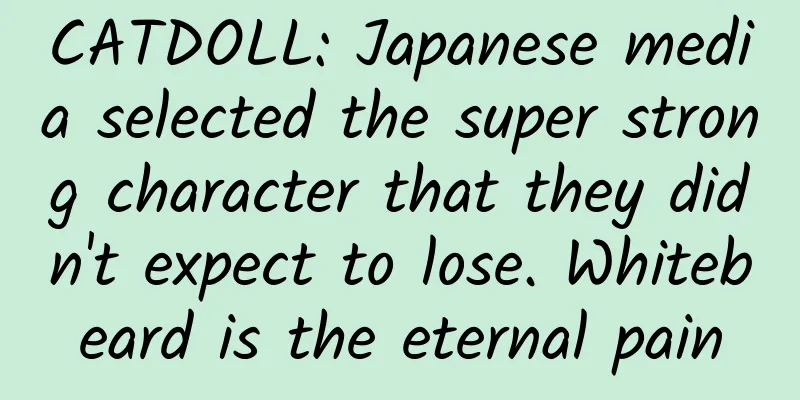CATDOLL: High-end technology geek analysis: Do you know how heavy Hatsune Miku's hair is?

|
When it comes to Japan's virtual idol Hatsune Miku, the most impressive thing is her super long twin ponytails, which are very beautiful. But what would it feel like if hair of this length and thickness really appeared in the real world? I guess people who have it will definitely want to cry, because it is really heavy. Now a high-end technology geek has calculated how heavy Hatsune Miku's beautiful twin ponytails are through various data. Let's take a look. This article is reproduced with the author's permission. If you need to reprint, please contact the original author. Let’s first search for information on the entry “Hatsune Miku” in Moegirlpedia. Original name: Hatsune Miku (hiragana: はつねみく, plain romaji: Hatsune Miku) Age: 16 Birthday: 2007.8.31 Zodiac sign: Virgo Height: 158cm Weight: 42kg Personification: Onion Cuteness: Twin ponytails, absolute territory Panties: Panties color distribution in official figures Good at: pop songs, pop and dance music, from old songs in the 80s to pop songs Best tempo: 70-150 BPM Note: Original setting is 80-150 Representative color: light green Voiced by: Fujita Saki It turns out that Hatsune Miku is 158cm tall. Why would someone born in 2007 be 16 years old? I really care about this... In addition, it seems that something extraordinary has been mixed in. Ahem, don't pay attention to these details. Go to the next step. Find a picture of Hatsune Miku and measure the following data: Calculated: Hair length (above the ponytail) 222cm (taking into account the spiral parts at ABC); Bangs length 18cm; Head length 25cm. Then find another picture to calculate the face ratio: Can I say that I spent a long time calculating that angle? Math nerds, please don't criticize me... Then calculate the side face: Next, roughly calculate the length of the hair under the ponytail to be about 16cm. The total length of the hair tied up like this is 222+16=238cm. Calculate the proportion of bangs and ponytail again—— The hair is 180° when viewed from the side, the bangs are 12°/180°=1/15, and the ponytail is 14/15. Then, consider the head as an ellipsoid and calculate the surface area (I am not good at math, so I downloaded a software to calculate it, unit: cm)—— Hair occupies half of the head's surface area, which is 782 square centimeters; The bangs take up 1/15 of the hair, which is 52 square centimeters; The ponytail occupies 14/15 of the hair, which is 730 square centimeters. Then calculate the number of different types of hair based on the density of the hair: The thickness of hair can directly affect the hardness of hair. Generally speaking, the harder the hair, the larger the cross-sectional area. Straight hair is the thickest, up to 0.1 mm; wavy hair is the second thickest, 0.08-0.09 mm; curly hair varies greatly, but most of them are thinner than wavy hair. The cross-sectional shape of straight hair is circular, that of wavy hair is slightly flattened oval, and that of curly hair is narrow and flat. Some people believe that thin and soft hair is easy to fall off, while hard and thick hair is easy to turn white. As for the density of hair, it is related to its thickness. The finer the hair, the denser it is. If expressed in terms of the number of hair roots per square centimeter, among the major races, white people have the most, followed by black people, and yellow people have the least. Someone once calculated that the average number of hair roots per square centimeter for Italians is 408, for Sudanese is 236, for Japanese is 238, and for Chinese is 224. (Source: Hair - Baidu Encyclopedia) Since Hatsune Miku is from Japan, we use 238 per square centimeter to calculate: Bangs 52 square centimeters, 12,376 strands; The horsetail is 730 square centimeters and contains 173,740 strands. To calculate the mass of hair, in addition to the length, you also need to know the density and diameter. As for the density of hair, I searched for a long time but couldn't find any ready-made information, so I had to find a way to solve it myself. Let's take a look at the structure of hair: When you go to a barber shop to get your hair cut, the hair shaft is usually the part that is cut short, and there are no nerves on the hair shaft, so you won't feel any pain (except when your hair is pinched). So when we calculate the weight, we only count the hair shaft, not the hair follicles. The cross-sectional structure of the hair shaft is as follows: Hair scales: Located on the outermost layer of hair, composed of epidermal keratin cells, covering the surface of hair like fish scales. The existence of hair scales helps to improve the strength of hair, resist external damage, and protect hair quality. At the same time, hair scales also determine the overall appearance of hair. Healthy hair scales should be complete and docile, and the surface of hair will be very smooth. When light shines on the hair, there will be a mirror-like luster, and the hair will look shiny and bright. But if the hair scales are damaged or even missing, then the rough surface will not be able to reflect light, and the hair will naturally lose its luster. Hair core: The hair core is located below the hair scales. It is the main part of the hair and accounts for more than 90% of the total weight of the hair. The hair core is mainly composed of keratin, which in turn is composed of amino acids. It provides the nutrients needed by the hair and therefore determines the color, elasticity, toughness, texture, etc. of the hair. Medulla: The medulla is the center of the hair and is located in the center of the hair shaft. It is a somewhat open structure that forms a loose central axis and may be intermittent or absent in the hair (depending on the diameter of the hair). The medulla adds extra thickness to the hair. The basic structure of hair is amino acid, which contains a central saturated α-carbon atom, an ammonium group, a carboxylate group and an R group to distinguish different amino acids. The ammonium in the amino acid reacts with the carboxylic acid to form a peptide bond. Different amino acids are connected by peptide bonds to form peptide chains. The amino acids in the peptide chain are called amino acid residues. This is the primary structure of the protein. The peptide chain as the primary structure generates the following secondary structure under the action of hydrogen bonds. α-helix: A common secondary structure in proteins. The peptide bond main chain is coiled around an imaginary central axis into a spiral shape. It is generally a right-handed helical structure, and the helix is maintained by intrachain hydrogen bonds. β-sheet, also known as β-plated sheet structure and β-structure, is a common secondary structure in protein and is composed of extended polypeptide chains. Human hair scales are mainly composed of keratin, which contains α-helices and β-pleated sheets, which reflect light. Hatsune's hair has a high reflectivity, so it can be considered that her hair scales are well maintained. The hair core occupies the largest proportion in the hair and is composed of α-helix. Therefore, hair is mainly composed of α-helical proteins. Since there is no data on hair density, I found data on wool fibers, which are also mainly composed of α-helical proteins, as a substitute. Through the density test of raw wool, chlorinated wool and stretched and refined wool, it was found that the data measured by using distilled water as the medium increased by 6% to 12% compared with the data of anhydrous ethanol, indicating that the water molecules with smaller molecular volume have a larger accessible area to penetrate into the fiber, making the fiber more fully immersed in the medium, and the measured density is closer to the true density of the fiber. (The above picture and text are selected from the paper "Liquid Buoyancy Method Test of Wool Fiber Density", by Dong Li, Zhang Jianfei, and Xu Lei) It can be seen that data A is equivalent to the density of dry wool (hair), and data B is equivalent to the density of wet wool (hair). I couldn't find the data on the diameter of hair in District 11, so I had to use this Chinese version of "Scanning Electron Microscope Observation of Hair Diameter of Healthy People of Different Ages" instead. Note that the prerequisite is that the hair is natural and cannot be dyed, otherwise the data will be inaccurate. So now the question is - is Hatsune's hair dyed? I think her hair is natural for the following reasons: See? It's just because the child has too much copper. Of course, there is another explanation: mutation. The average person's hair grows about 15cm a year. Hatsune is 16 years old this year, and if it is not trimmed, it will grow to 240cm. The number of 238cm measured before is very close to it, so we can conclude that Hatsune has never had her hair cut since she was born. After about two months, hair is oxidized by air, water, sunlight, etc., and pigment particles are continuously lost, which will cause fading, just like a new piece of clothing. If you wear and wash it many times, it will naturally fade. KingLee believes that you should re-dye your hair at this time. Generally, hair dyeing can keep the color basically unchanged for 6-8 weeks, or withstand 16-20 shampooings. After dyeing your hair, you need to re-dye it in time. When the new hair grows 2-3 cm, you should go to a professional hair salon for re-dyeing. Re-dyeing is both a process of consolidating the dyed hair color and a process of hair care. If her hair is dyed, she would have to re-dye it 6 times a year. Hatsune has kept her hair green for at least 8 years since her debut in 2007, which means she would have to re-dye it 48 times, which is very harmful to her hair. As a young girl, she should cherish her long hair, so it is unlikely that her hair is dyed. Okay, now that the conditions are met, we can apply the data. The data showed a normal distribution, with the mean hair diameter of the 10-19 age group being 91.76 μm and the standard deviation being 16.32 μm. That is, f(x)~N(91.76,16.32^2). and its images It can be obtained that the probability is the highest at x=μ. In other words, the diameter of Hatsune's hair is most likely to be 91.76μm (0.09176mm). Now we can do the calculation: The cross-sectional area of a single hair is π(0.09176/2)^2=0.006613 (sqr.mm); the linear density of hair is 0.006613/100*1.2432=8.2212*10^-5(g/cm); including bangs and ponytail: (12376*18+173740*238)*8.2212*10^-5=3418(g). The total weight is a little over 3.4 kilograms, nearly 7 pounds . Now let me go off topic and ask myself this question: "What does it feel like to carry a 3418-gram weight on your head?" A peaked cap weighs about 80 grams, so 3418 grams is equivalent to 43 peaked caps. It's about like this: The picture is too beautiful to imagine... Author: Shinnippori; Original article address>>> |
<<: CATDOLL: Japanese snack manufacturer sends snack gift pack to the author of "Himuko Komaru-chan"
Recommend
CATDOLL: "Digimon Adventure tri." Chapter 4 "Loss" poster released, released on February 24, 2017
The promotional poster for the fourth chapter of ...
CATDOLL: "Would You Like a Rabbit Today?" Season 2 Promotional Event at PVC88
The animation "Excuse Me, Is the Order a Rab...
CATDOLL: I admire you so much! Nicole, the voice actor of Love Live!, drew a picture to celebrate Umi Sonoda's birthday
Today (March 15) is the birthday of Umi Sonoda, o...
CATDOLL: The latest movie information of "Detective Conan" will be released next week
The theatrical version of "Detective Conan&q...
CATDOLL: American animators complain about inhuman treatment while working in Japan
Determined to join the Japanese animation industr...
CATDOLL: "Painting Rivers and Lakes: The Bad Guys" Season 2 Episode 28 Black and White Impermanence finally obtains the skills
The 28th episode of the second season of "Pa...
CATDOLL: Hideaki Anno leads the production of the short animation "HILL CLIMB GIRL" broadcast today
The second short animation "Hill Climb Girl&...
CATDOLL: "Night of the Twins" announces that some of the main voice actors, including Kitamura Eri, will join
After announcing the staff, opening credits, endi...
CATDOLL: Anime Starry Sky Evening News: Experts explain what is a "real otaku" "One Piece" comics Blackbeard knows the headquarters of the Revolutionary Army
Good evening, everyone. It's time to review t...
CATDOLL: Japanese netizens discuss: Why is the original work so good, but the animation is so bad?
When novels and comics are adapted into animation...
CATDOLL: The theme song MV of "Painting Rivers and Lakes: Never Stop Drinking" is released, and the love-hate relationship reappears in the bloody battle
The new member of the Chinese animation "Pain...
CATDOLL: Is this the beginning of a new chapter or the end? The contents of the 11th volume of the novel "My Teen Romantic Comedy Is Wrong, As Expected" are revealed
The light novel "My Teen Romantic Comedy Is ...
CATDOLL: "Twin Stars Onmyoji" animation episode 36 preview picture girl defeats the enemy with one move
The preview image of the 36th episode of the anim...
CATDOLL: The correct use of welfare game posters: a good partner for shooting practice
They say anime can cure diseases, don't disbe...
CATDOLL: Anime Starry Sky Evening News: "Your Name." The domestic release date is December 2nd. Kimura Takuya will star in the live-action movie "Blade of the Immortal"
Good evening, everyone. It's time to review a...









